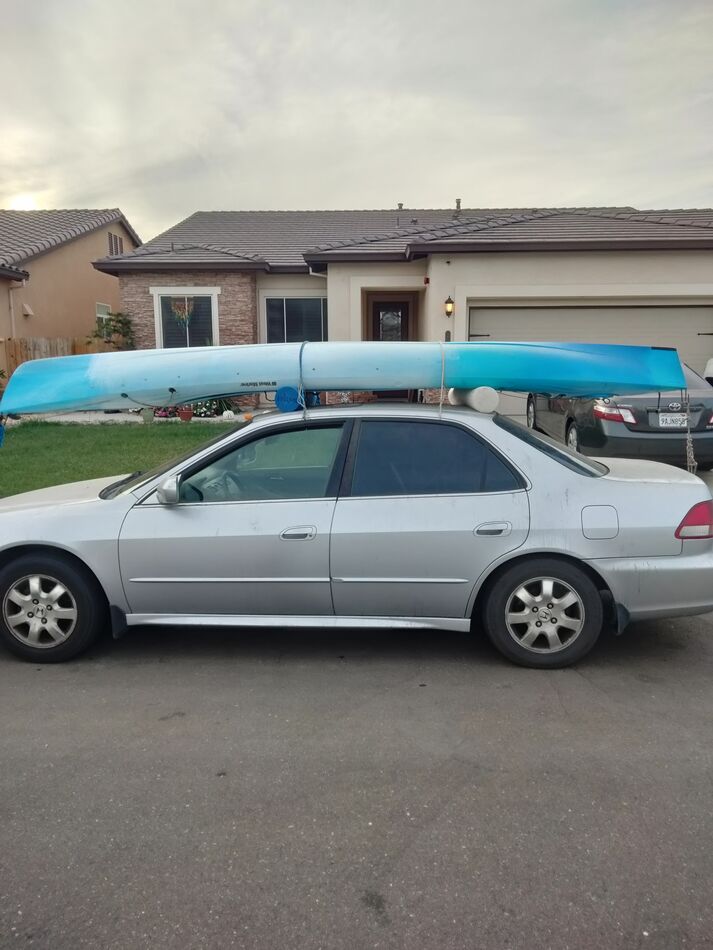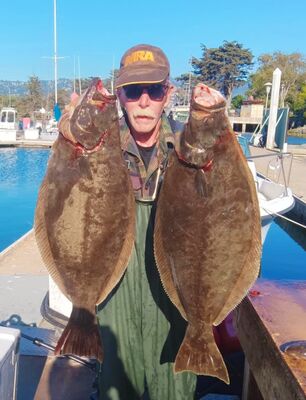Kayak body lanyards, ever use one?
Maryland Fishing
Oct 29, 2022 12:55:13 #
I often though about what if i were to go overboard and the current was fast enough to carry the yak away faster than i could swim.
So any of you kayakers ever use a body lanyard and if so what type?
So any of you kayakers ever use a body lanyard and if so what type?
Oct 29, 2022 13:08:49 #
I don't want to be tethered to something like that in swift water. If it gets caught in a vortex, you're going too and will probably drown. Get the highest flotation PFD and make sure it's the correct size.
Oct 29, 2022 13:14:40 #
UncleRob wrote:
I don't want to be tethered to something like that in swift water. If it gets caught in a vortex, you're going too and will probably drown. Get the highest flotation PFD and make sure it's the correct size.
best advice here Plum
Oct 29, 2022 13:21:16 #
Oct 29, 2022 13:31:57 #
El Rod
Loc: Port A
plumbob wrote:
I often though about what if i were to go overboard and the current was fast enough to carry the yak away faster than i could swim.
So any of you kayakers ever use a body lanyard and if so what type?
So any of you kayakers ever use a body lanyard and if so what type?
Uncle Bob is so right.😎👍
Oct 29, 2022 13:41:42 #
UncleRob wrote:
I don't want to be tethered to something like that in swift water. If it gets caught in a vortex, you're going too and will probably drown. Get the highest flotation PFD and make sure it's the correct size.
Good point UncleRob but that is just one scenario. I was leaning on the worse case if you were to go over from lets say a heart attack. At least the yak would be a better floater to hold on to in conjunction with the PFD.
Only twice i was in the yak without the PFD and when i realized it back i went. Left it on the passenger seat once and the other right where i wouldn't forget it. Wrong!!!!
Oct 29, 2022 16:19:35 #
plumbob wrote:
Good point UncleRob but that is just one scenario. I was leaning on the worse case if you were to go over from lets say a heart attack. At least the yak would be a better floater to hold on to in conjunction with the PFD.
Only twice i was in the yak without the PFD and when i realized it back i went. Left it on the passenger seat once and the other right where i wouldn't forget it. Wrong!!!!
Only twice i was in the yak without the PFD and when i realized it back i went. Left it on the passenger seat once and the other right where i wouldn't forget it. Wrong!!!!
As a former USCG Rescue Swimmer, no PFD, NOT EVEN ONCE. One place where my cheapassness NEVER takes over is on my PFDs. While I still swim like a fish, I'm almost 40 years down the road from my last rescue and an MI is a possibility as well as a host of other things. Get a good open water PFD if you're fishing that sort of water, they're made to hold your head back. They're not cheap, but what price do you put on your life or others in your boat.
Oct 29, 2022 20:49:06 #
plumbob wrote:
... and the current was fast enough to carry the yak away faster than i could swim.
PB,
Caveat: I'm not an expert but I have 50 years worth of practice making mistakes with kayaks (offshore, SF Bay and SJR Delta--no whitewater river).
It's not the current carrying your kayak away that is the problem (ie, the current will carry you at the same speed and direction as it does the kayak).
The problem is having the current carrying you one direction and the wind blowing your kayak in another direction or faster than you're traveling in the current.
When I'm drifting a narrow and relatively slow river (ie where I can swim to shore), I will place my anchor and anchor rope in a small/open bucket on the stern so that if I tip over the anchor drops to the bottom and keeps my kayak from drifting down current. I can always swim to shore, walk back up above my kayak, swim out and get in, pull anchor and continue my trip.
In open water I will set my drogue on the stern so that it deploys if I end up going for a swim. The drogue will catch in the current and prevent the kayak from blowing away faster than I can swim.
The one I use has an adjustable spill--an opening at the back that has a draw cord.
I (now) carry my drogue on every trip because it has other uses. Here's a couple of examples:
(1) I paddled up the San Joaquin River thinking that I would just drift back to where I was camped when I was done fishing. Unfortunately the wind picked up and I had to paddle harder against the wind to go down stream than I did going upstream. If I had had my drogue with me I would have thrown it in the current and let the river current carry me back to camp.
(2) Drift Fishing in the SF Bay -- drift one way with the wind (no drogue) then back the other way with the tidal current (drogue deployed). Takes planning but beats paddling all day!
(3) Taking a short break from paddling.
(4) When I hook a large fish. Not only does it provide drag without having to set an anchor (not advisable), but also provides a pivot point so that if the fish goes sideways you can swing the bow instead of having your rod 90° from the direction your kayak is pointing (with a large fish you want your line entering the water near the bow not off the side).
(5) Slowing down when you're surfing down a big steep wave and preventing the bow from submarining into the back of the next wave (getting the lead length and spill right is tricky... get professional help).
(6) Deep water conditions or over snaggy bottoms.
In any case I would highly recommend AGAINST a body leash. Nearly all of my close calls (near drownings) were from getting tangled to an attached cord.
I do attach my paddles. If I tip I'll hang on if I can (90%), if I can't, no biggie and I still have my paddles.
On a side note, make sure your paddles float after all the bubbles are gone when you submerged it. If it doesn't float, pack some foam down
both handle halves.
If there is anyone that would like some SF Bay or Delta specific tips, PM me.
Aside from always wear a PFD, file a flight/float plan (from an old SARs guy).
Hope this helps,
PapaD
Where I store my kayak May-December

Oct 30, 2022 06:50:08 #
Definitely let someone know where you're going (GPS coordinates would be great) and when you'll return. That way if you're not back they can launch a search a lot sooner. The second year we had our boat it broke down and I went back to retrieve it the next day. I told my wife that if I wasn't back by 1200h to notify the USCG and tell them to start a search from the mouth of the Baltimore Harbor and end at the Bush river behind Pooles Island. I called in at 1150h. Needless to say the weather and waves were miserable, it was March. I spent most of the time between the 2 chairs behind the console.
Oct 30, 2022 10:08:27 #
Papa D wrote:
PB, br br Caveat: I'm not an expert but I have 5... (show quote)
Papa D Thank You for taking the time to write some very informative information there. I have heard the same horror stories of folks getting tangled in lines so that didn't surprise me.
What i did find very interesting is the drogue use. That i don't have nor a body lanyard.
This thread was posted to get a conversation going among us yakers and for my self to see if a body lanyard is worth it. My thought when posting was if i went over that the yak with me holding on would be easier to find than just me floating along. I guess it would depend on who and what was being used for the search.
I was in a few search missions in NC with my Sea Pro at the time and was amazed how many different crafts answer the call. The bigger the floater the easier was my mind concept.
Mentioning to my Mrs where i launch is a must do before venturing out with a reminder when i get to the location. Also have found that cell phone locator is a good thing to have also.
Thanks again for the detailed post.
Oct 30, 2022 15:04:02 #
Regarding float plans and helping SARs find you...
From my SARS days (marine and mounted patrol).
1. Time is critical, whether it's related to hypothermia or mt. lion feeding schedule.
2. It takes a LOT longer to find someone if you don't know where to start looking. In the olden days, I used to tell folks to not only let someone at home know but leave a note taped to the car window that gives info on where you're heading once you leave the parking lot, the departure time (especially useful to SAR when you have current that changes with the tides), an estimated return time and what channel I have my walkie set to. I now send my wife a text that includes a pin drop (in case my planned launching point changed) and I leave the note on the window.
3. While staying with your kayak is best. If SARs spot your yak, they can narrow the search for you considerably but will have to expand for wind factors if there's no drogue deployed.
4. While a flare gun is best, you will probably end up in the water without it. I made a small pocket on my PFD where I keep 3 relatively new glow sticks (regularly rotated out with my night fishing ones) and a 3x5 signal mirror (learn how to use it and practice on dry land). I also keep my walkie clipped to me.
4. On EVERY PFD I own there is a whistle attached. (Think how Kate Winslet's character saved herself in Titanic). If you're lucky enough to have another boat closeby, it is the best thing to have. I strongly recommend the Storm Whistle model that West Coast Marine sells (loud enough to be heard 15' under water--3 miles above).
5. Even in relative warm water, hypothermia kills. Take precautions and learn how to combat it.
6. Do not depend on your cell phone in MOB situations. If it works, great-- often it doesn't (no signal, got wet, cell carrier won't cooperate, etc.)--take it with you, just don't DEPEND on it.
From my SARS days (marine and mounted patrol).
1. Time is critical, whether it's related to hypothermia or mt. lion feeding schedule.
2. It takes a LOT longer to find someone if you don't know where to start looking. In the olden days, I used to tell folks to not only let someone at home know but leave a note taped to the car window that gives info on where you're heading once you leave the parking lot, the departure time (especially useful to SAR when you have current that changes with the tides), an estimated return time and what channel I have my walkie set to. I now send my wife a text that includes a pin drop (in case my planned launching point changed) and I leave the note on the window.
3. While staying with your kayak is best. If SARs spot your yak, they can narrow the search for you considerably but will have to expand for wind factors if there's no drogue deployed.
4. While a flare gun is best, you will probably end up in the water without it. I made a small pocket on my PFD where I keep 3 relatively new glow sticks (regularly rotated out with my night fishing ones) and a 3x5 signal mirror (learn how to use it and practice on dry land). I also keep my walkie clipped to me.
4. On EVERY PFD I own there is a whistle attached. (Think how Kate Winslet's character saved herself in Titanic). If you're lucky enough to have another boat closeby, it is the best thing to have. I strongly recommend the Storm Whistle model that West Coast Marine sells (loud enough to be heard 15' under water--3 miles above).
5. Even in relative warm water, hypothermia kills. Take precautions and learn how to combat it.
6. Do not depend on your cell phone in MOB situations. If it works, great-- often it doesn't (no signal, got wet, cell carrier won't cooperate, etc.)--take it with you, just don't DEPEND on it.
Oct 30, 2022 16:06:30 #
UncleRob wrote:
I don't want to be tethered to something like that in swift water. If it gets caught in a vortex, you're going too and will probably drown. Get the highest flotation PFD and make sure it's the correct size.


Oct 30, 2022 16:28:39 #
Papa D wrote:
Regarding float plans and helping SARs find you...... (show quote)
Some more good points there Papa, I just started keeping a whistle on board never thought to put it on the PFD until now. Had the compressed air horn wasn't to reliable when i checked it out on land once. Really like the glow stick idea, i can see where that would come in handy.
Yes, hypothermia is nothing to mess with. The few times i was involved in searches the water was in the low 70's and didn't think of that since the GC was involved. Good to know.
Oct 30, 2022 20:09:44 #
Gmchief
Loc: New Hampshire coast
My wife has a picture of my truck with license plate, and one of my boat with numbers and trailer plate. She knows where I launch and where I will be fishing. Most of my fishing is near inshore so I tell her what NOAA chart I will be in. I call her when I leave the launch and when I’m back.
Oct 31, 2022 13:44:41 #
Papa D wrote:
Regarding float plans and helping SARs find you...... (show quote)
Add to #3: In order to ensure that your drogue deploys, you may want to consider attaching it with velcro to the back of your PFD.
Add to the list:
#7. You might want to add a personal ERB. Look for features like this model sold at Bass Pro (I'm not recommending this model just the features that it has... You'll have to do your own research)
ResQLink 425 Buoyant Personal Locator Beacon
Then attach it to your PFD.
#8 DO NOT HARD TIE YOUR ANCHOR LINE!!! DO NOT HARD TIE YOUR ANCHOR LINE!!! DO NOT HARD TIE YOUR ANCHOR LINE!!!
One of the most tragic and unsuccessful searches that I participated on was a case of a young man who had hard tied his anchor and himself to his kayak while fishing in the San Joaquin Delta.
His body wasn't recovered until few weeks later when the water logged tree that had snagged his anchor got caught in the shallows near Big Break. The tree had snagged his anchor line and probably pulled both him and his kayak under the surface.
Instead of hard tying (including using a cleat), learn and use a Tumble or Highwayman's Hitch. Make sure to leave the free end where you can reach it so that you can give it a yank.
If your line doesn't float, you will want to attach a small float on the very end so that you can recover your anchor.
Make sure that ALL of your line is free to go overboard when it is cut loose. I keep my anchor and line in a bucket that sits behind me (see earlier post).
If you want to reply, then register here. Registration is free and your account is created instantly, so you can post right away.





